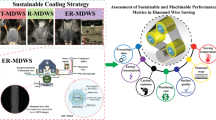Abstract
A new method using the response surface method and optimization technique has been developed instead of the original method based on trial and error. In order to construct a response surface, thermal analysis was performed under the condition of using the calculated thermal conductivity of the insulator in a previous study. In order to set up the response surface, the D-Optimal method was used in the process of selecting experimental points. Using a weighting factor, an optimization study was carried out under the condition of satisfying user requirements. Finally, the merits and drawbacks of the new method were described by comparing with the optimal design method based on the thermal analysis database which was developed in a previous study. The optimal results show that the developed method can be used to design an energy efficient, low manufacturing cost, high temperature vacuum furnace with avoiding unnecessary iterative manufacturing, and anticipating the performance before manufacturing.
Similar content being viewed by others
References
Metal Network Korea, What’s the present state and future of our industrial furnace industry on 2003, Industry Journal News Co. Ltd, (2003).
J. W. Lee, High efficiency and very high temperature vacuum furnace design technique development using MDO(Multi-disciplinary Design Optimization) method, Technical Report, (2003).
M. J. Kim, H. G. Jung, J. W. Lee and C. J. Lee, Optimal design of energy efficient vacuum furnace using thermal analysis database, Key Engineering Materials 277–279 (2005) 732–740.
Z. Z. Li, Y. D. Shen, K. S. Heo, J. W. Lee, S. Y. Seol, Y. H. Byun and C. J. Lee, Feasible optimal design of high temperature vacuum furnace using experiences and thermal analysis database, Journal of Thermal Science and Technology 2(1) (2007) 123–133.
M. F. Modest, Radiative Heat Transfer, McGraw-Hill, New York, USA, (2003).
CFD Research Corporation, CFD-ACE Users Manual, (2004).
R. H. Myers and D. C. Montgomery, Response Surface Methodology, John Wiley & Sons Inc, New York, USA, (1995).
VR&D, DOT Users Manual, (1995).
J. S. Arora, Introduction to Optimum Design, McGraw-Hill, New York, USA, (2001).
Author information
Authors and Affiliations
Corresponding author
Additional information
This paper was recommended for publication in revised form by Associate Editor Ohchae Kwon
Rights and permissions
About this article
Cite this article
Li, ZZ., Shen, YD., Xu, HL. et al. Optimal design of high temperature vacuum furnace using response surface method. J Mech Sci Technol 22, 2213–2217 (2008). https://doi.org/10.1007/s12206-008-0617-0
Received:
Revised:
Accepted:
Published:
Issue Date:
DOI: https://doi.org/10.1007/s12206-008-0617-0




